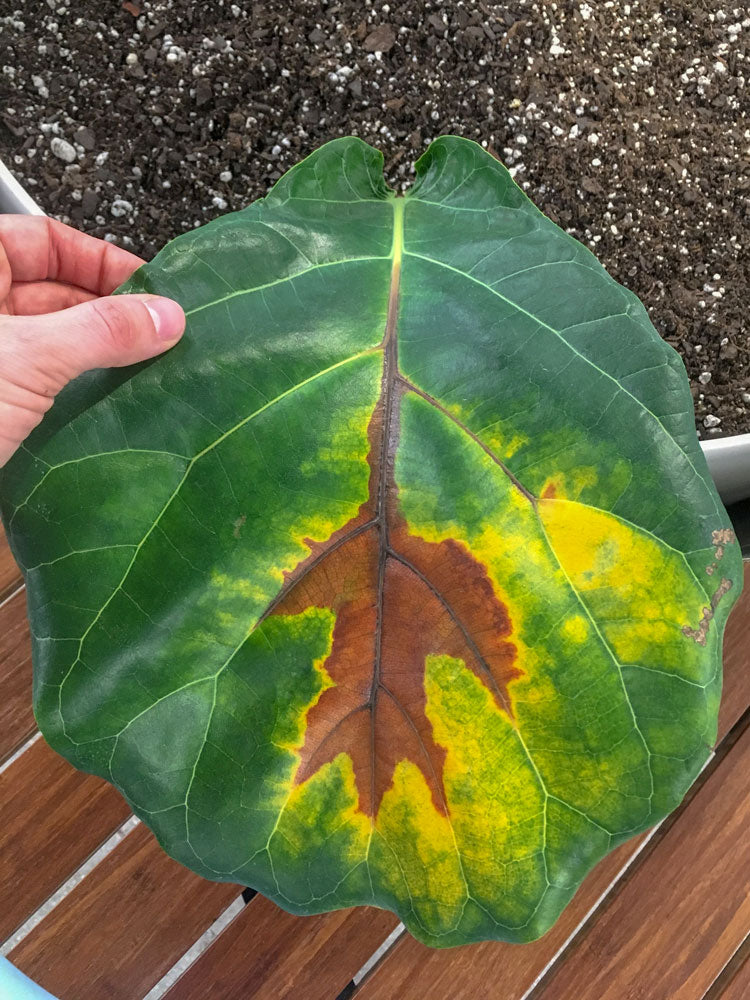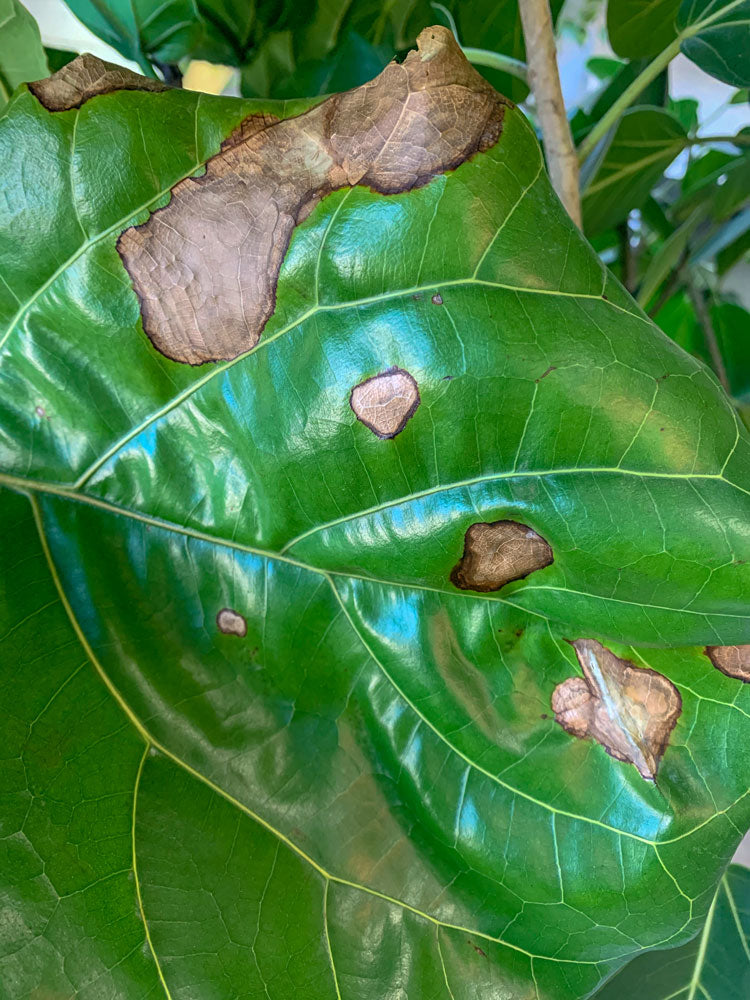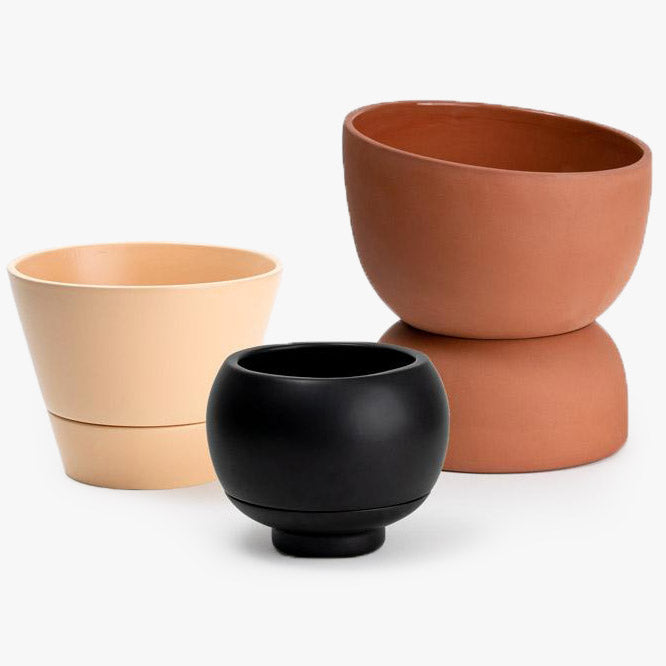Fiddle Leaf Fig Care
Placement
PRO TIP: Rotate your tree once a month to keep it standing straight and tall. Fiddle Leaf Figs in particular like to reach towards the light, so if you don’t rotate you’ll notice them bending over time.
Native to the rainforests of western and central Africa, the Fiddle Leaf Fig Tree (Ficus lyrata) is a stunning plant with huge green leaves and an even larger following of houseplant fans. Despite its popularity, it's certainly not the easiest houseplant to look after, but its visual impact in a space is unmatched when given proper conditions and care.
The Fiddle Leaf Fig appreciates a warm, humid environment, a fair amount of water and plenty of light. Choose a location away from air vents and drafts where the tree will receive plenty of bright ambient light. Directly in front of, or close by a southern or western facing window is ideal, and eastern exposure can also work as long as the plant is directly in the window and the space feels very bright. A few hours of direct sun is also beneficial. If placed in a full-sun location (where the plant will receive over 6 hours of direct light daily), a humid environment will keep your Fiddle Leaf looking its best. We do not recommend this plant for windows with northern exposure. They will not thrive in low-light locations.
If you’re unsure about your lighting conditions, placing the tree directly next to the window is the safest bet. We also have a guide for how to measure light in your space.
Fiddle Leaf Fig Trees are particularly sensitive to environmental changes. They will likely take a little time to adjust to their new home. Be sure to follow the care instructions, and don’t panic if yours loses a few leaves. If leaf discoloration or leaf loss persists, please reach out and we will help troubleshoot!
Lastly, if you are using a container made from organic materials to pot your Fiddle Leaf in, we highly recommend using a waterproof saucer underneath to protect your floors, as humidity may accumulate beneath the pot due to the volume of water this plant requires.

The common name for this plant, Fiddle Leaf Fig, comes from the fact that the leaves are the size and shape of a fiddle.
Routine Maintenance
PRO TIP: Every three months, rinse your plant’s leaves with room temperature water. This helps remove any dust that’s accumulated, ensuring they’re able to absorb and photosynthesize sunlight more efficiently.
Always be sure to assess your plant’s watering needs upon receiving it. Before giving your plant a drink, it is best to check the moisture level in the soil first to ensure it isn’t moist right beneath the surface. Also, consider aerating the soil of your plant before the initial watering. Many growers compact the soil to avoid shifting during transit, so aerating can aid in drainage, help the soil breathe and allow moisture to be released.
The Fiddle Leaf Fig likes its soil to be kept consistently, evenly moist with a brief drying out period between waterings as it comes from an area of the world that gets very dry between rain storms. Water it thoroughly whenever the top 2” of soil have dried. Allowing the soil to dry deep to the lower root system will lead to leaf loss, so be sure to check in with the soil regularly until you develop a routine with your plant. In contrast, too much moisture in the soil can lead to root rot and also cause leaves to drop.
The best way we have found to obtain an accurate moisture reading throughout the soil is with a soil probe, which allows you to check your plant's moisture level at the root level and can also be used to aerate the soil if ever overwatered. Our Monitor Brass Soil Probe is an elegant option.
We highly recommend potting your Fiddle Leaf, as it is a challenging plant to keep alive long term in its nursery pot — however make sure to pot it in a permanent planter with plenty of soil mass and crucially, drainage. If your Fiddle Leaf Fig is planted in a container without a drainage hole, you must be very careful not to overwater. In this scenario we suggest allowing your Fiddle Leaf Fig to dry out slightly more between waterings and use a soil probe to see how damp the soil is at the root level before watering. These plants do particularly well in our self watering containers!
Recommended Pots for the Fiddle Leaf Fig
Frequently Asked Questions
Does my Ficus have a bacterial infection or root rot?
- Probably not. Although the internet is ablaze with this diagnosis, we've found this affliction to be exceedingly rare in the thousands of Ficuses we've cared for through our sister company, Greenery NYC. It's probably another problem such as low light or overwatering. However, we have a guide on how to identify fungal and bacterial leaf spotting if you're interested in learning more.
Help! My Fiddle Leaf Fig dropped a leaf!
- Ficus trees are sensitive to environmental change and transplanting. The dry, cold air is a big shift from the warm humidity of the greenhouse, and Ficus will temporarily go into shock and drop leaves. Don’t worry, this is a temporary state. It will take a couple of weeks for your tree to normalize and it might drop a couple of leaves in the process. However, if the leaves continue to drop it could be a sign of improper light or water.
My Fiddle Leaf Fig has brown spots and the leaves are dropping. What do I do?
- The number one mistake most people make in taking care of their plants is overwatering. Fiddle Leaf Fig Trees prefer to dry out slightly between waterings, and while they take a good deal of water to keep healthy, soggy soil will drown the plant. If your leaves start to brown and fall and the soil is moist, let the plant dry out until the soil becomes completely dry.
- The second biggest mistake people make is not enough light. Fiddle Leafs need a lot of light to thrive and will start shedding their leaves if they’re not absorbing enough energy. If you’re unsure about where to put your plant, it’s best to place it by a window. For more information visit our lighting guide.
- Underwatering can also be a big killer of the fiddle leaf fig. When underwatered, the rim of the leaves will start to brown and curl in, which will eventually spread throughout the leaf. Underwatered leaves that have fallen will normally be either fully brown or mostly brown, and dry to the touch.
How do I tell when my Fiddle Leaf Fig Tree needs water?
- Once you've established that the top few inches of soil have dried, the easiest way to tell if your Fiddle Leaf needs water is to look at the leaves. If the leaves are not rigid and upright, and they start to look floppy, they’re telling you they need water. Be sure to check in regularly with your tree to ensure you don't underwater until you establish a routine.
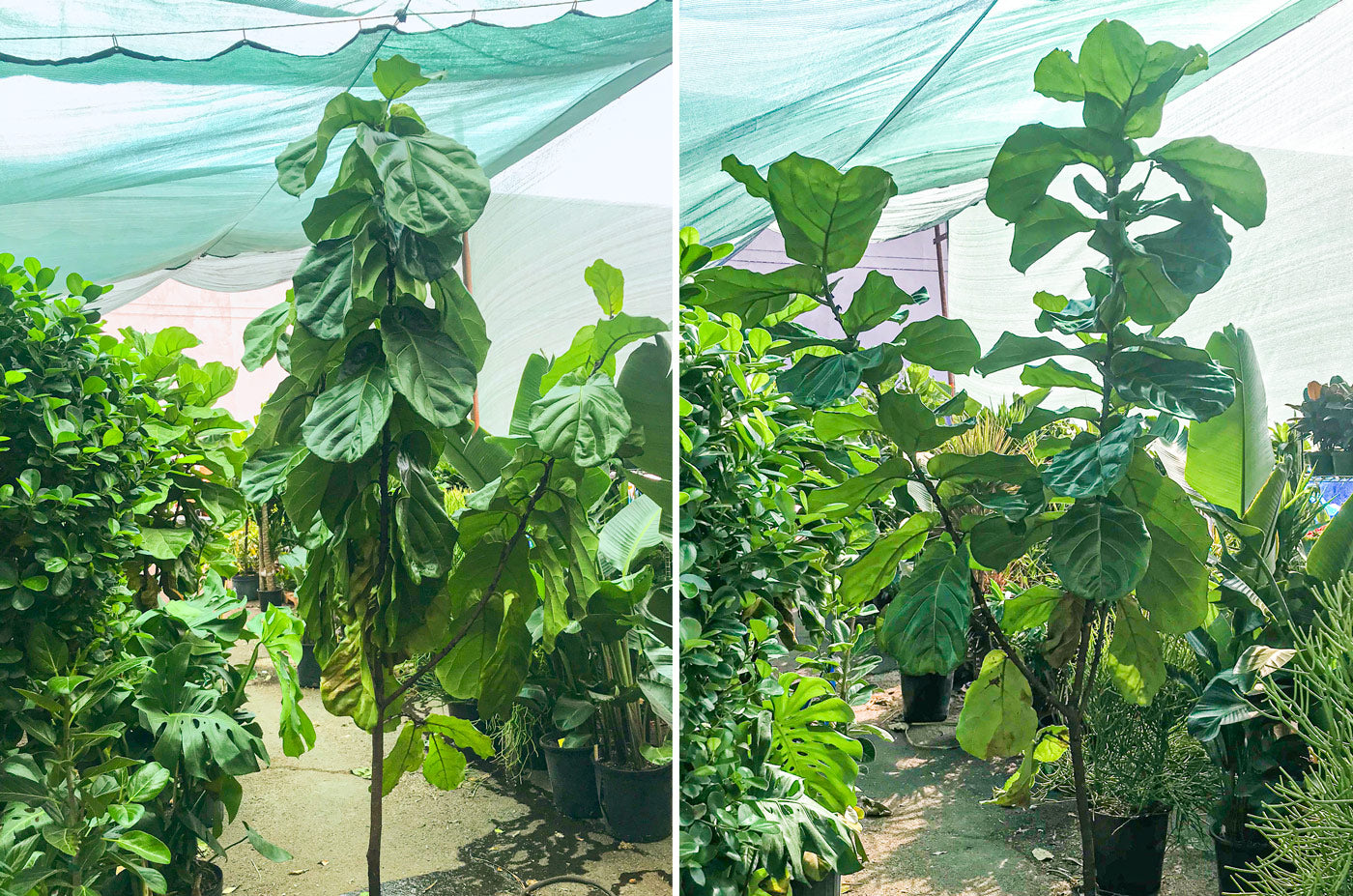 An underwatered Fiddle Leaf Fig tree on the left, and the same tree less than 24 hours later.
An underwatered Fiddle Leaf Fig tree on the left, and the same tree less than 24 hours later.
How much light is too much light for the Fiddle Leaf Fig?
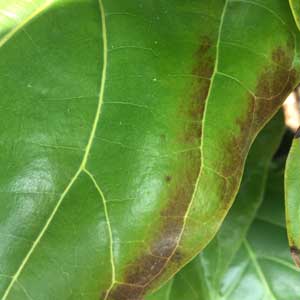 Sunburn on a Fiddle Leaf Fig's leaves.
Sunburn on a Fiddle Leaf Fig's leaves.
- Fiddle Leaf Figs will generally do fine if placed right in front of a window in NYC. However, they can’t take extended periods of full sun (being placed outside on a sunny day). In extremely bright apartments (i.e. floor to ceiling windows) they may get sunburned, and in this instance your safest bet is putting them in front of the window with a sheer curtain. Do not block the light with a partial shade like a solar shade as they will block out the full spectrum of the sun’s radiation.
Can I put my Fiddle Leaf Fig Tree next to the AC / heater?
- Fiddle Leaf Fig Trees are tropical plants that appreciate a humid environment. If conditions are too dry they will drop their leaves. While Fiddle Leafs will thrive in an air conditioned apartment, always avoid putting them in the direct line of fire for either AC or heating units. If their leaves are wagging from the air, it’s best to find another spot.
How often should I fertilize my Fiddle Leaf Fig?
- In general, house plants will thrive when they are fertilized spring through fall. Fertilize once a month with an organic houseplant fertilizer, following the package instructions for dilution and administration. Greenery NYC uses an organic potting mix with a slow release fertilizer in the soil, so your plant will not need fertilizer within the first 6 months of receiving it.
How often does my Fiddle Leaf Fig need to be repotted?
- For larger floor plants, we suggest repotting every 18-24 months. Typically you want to choose a potting vessel 2”- 4” larger in diameter to allow for growth. Don’t choose a pot much larger than the previous as this could drown the plants roots. If you prefer to maintain the current size of your plant, repot into the same vessel, providing new soil and trimming away some roots and foliage. Spring or summer is the ideal time to repot as the plant is at its strongest.
Standard Planter Instructions
All of our Standard Planters include a removable drainage plug to give our customers the option of drainage. While no drainage is sometimes preferred for its aesthetic simplicity, we don't recommend this option for beginners as watering mistakes can be hard to rectify.
Whether you choose to use drainage or not, we always recommend using a layer of drainage (such as our Aeration Stones) at the base of the planter. A drainage layer allows the plant's roots access to oxygen in the pockets between the drainage medium, and a lack of drainage can cause anaerobic damage to your plant.
If you decide to utilize the drainage hole for your pot, make sure to include a Plant Saucer beneath your pot to collect excess water. For most plants in standard planters, we recommend watering about once a week. Water the soil mass until water begins pooling in your Plant Saucer.
With no drainage hole, you will need to be more precise in your watering. While we would love to give you a specific measurement of water to provide for your plant, the reality is that a plant's water requirements vary wildly depending on factors such as light exposure and the overall health of the plant. You will need to learn to tell when the plant is thirsty based on how its foliage looks. Droopy foliage is usually the first sign: when your plant looks a little slumped over that's usually a visual indicator that it's thirsty.
The best solution for checking your plant's moisture level, drainage hole of not, is to use a Soil Probe to determine the moisture content of the soil at the bottom of the planter.
Self Watering Planter Instructions
The Self-Watering Planters require a deep and thorough watering of the topsoil after they are first planted. This is important because the roots of the plants first need to grow into the reservoir in order to drink from it. Water your plant from the top for two to four weeks before using the reservoir. During the dormant seasons, or for plants that have slower growing habits, consider top watering for longer.
TEST: After the initial top water period, fill the bottom water reservoir. If the water in the reservoir is absorbed into the planter, it means the plant is ready for regular reservoir servicing. If not, be sure to continue top watering for a few more weeks until the plant has started drinking from the reservoir.
RESERVOIR SERVICING: Once the reservoir empties on its own, do not refill the reservoir right away. Similar to how humans need a breath of air between gulps of water, most plants require a drying out period. Allow for the reservoir to empty all the way between watering. All plants are different in their needs so the amount of time the reservoir sits empty will need to be determined, but know that for most plants this period is between 1-3 days.
From here on out, you should rarely topwater the plant while using the reservoir system. Watering from below allows the plant to drink at its own pace, and can help combat certain issues like fungus gnats by allowing the top layer of soil to dry out more. Please note that if your plant's soil dries out too much, it can impair the wicking ability of the Aeration Stones in your planter. If your soil becomes too dry, we recommend giving it a thorough watering.
For more information on our Self Watering Planters include planting instructions, visit our blog post on How to Use Our Self-Watering Pots.
Recommended Accessories
Aeration Stones
Aeration Stones promote healthy root growth by creating air pockets in the soil and absorbing excess water in the basin of your planter. These porous clay stones are a natural, efficient and invaluable material to set your plant up for success. We always suggest using these when working with a planter without drainage holes.
ARS Stainless Steel Pruners
Salts and moisture from potting soil wreaks havoc on cheaper metals. Stainless steel is one of the most durable metals available on a consumer scale, and these heavy duty pruners are built to take a beating. Great for pruning jobs large and small.
Neem Oil
Neem Oil is an all purpose insecticide, miticide, and fungicide used for organic gardening. It's systemic, which means the plant will absorb the neem oil into its circulatory system and poison pests from within. Be careful not to overuse, as this can weaken plants and cause discoloration.
Soil Probe
Plants do poorly without air to the roots. Overwatering causes the air to be pushed out of the soil, compacting the soil around the waterlogged roots of the plant. Using the Soil Probe aerates the soil as it checks for moisture.
Watering Can
Watering cans come in all shapes and sizes, and the perfect one for your home is the one you're happiest living with. Look for long spouts and a container volume that's appropriate for your plant collection.
Soil
Fox Farm Ocean Forest contains all the features we look for when aiming to ensure the long term health of a plant: excellent water retention, breathability, texture, and is made from organic materials.
Fertilizer
10-4-3 fertilizer is a great, gentle choice for indoor foliage. Simply mix this in to your watering can using the supplied directions every other week. Ensure that your plant is receiving a good amount of light, otherwise it won't have the energy to process the nutrients and burnt tips may occur on the foliage.
Cork Mats
Protects furniture and floors from scratches and moisture. HIGHLY RECOMMENDED for use with planters made from organic materials such as ceramic.



